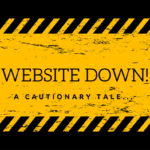I was treated to a behind the scenes look into the podcasting process with my old friend Barry Lee Cummings last week. I was invited to join him as a guest on his well-established podcast, Swenglanese, as well as being given invaluable advice and guidance on the editing and production process, for which I am eternally grateful.
You can watch the episode here, and I would also highly recommend subscribing to his podcast to hear interesting stories and advice from a wide variety of entrepreneurs and business professionals across the UAE.
Following his expert insight and my first experience in the world of podcasting last week, I thought I’d share some of my learnings, a lot of which I have talked about before on this blog in terms of other forms of communications, such as videos and interviews, as well as a couple more focussed on podcasts themselves:
Know the angle/talking points in advance
You want to make sure you are coming across as confident, knowledgeable, personable and relaxed, so you need to be fully prepared. Don’t expect to get a scripted list of questions – podcast interviews should be more conversational in tone – but it is perfectly acceptable to ask what the general agenda topics will be. At this point you can also advise any areas you may wish to avoid, and areas you would like to focus on.
Think about what you want you want to achieve
Why are you doing this podcast/interview? Are you trying to change or strengthen people’s opinions? Educate the audience? Raise awareness of an issue? How can this session achieve that objective? Firstly, you need to know who the audience of the blog is, and then you need to think about what you want to say to them, and the way you want too come across, in order to make the desired impact.
Have a clear message
Know your key messages – you want to be consistent and clear in what you say. Limit yourself to 2-3 messages for the entire podcast however, and don’t be a robot, these should not be churned out as a sales pitch, but used in the context of the conversation. Identify the appropriate call to action, as well as the introduction and closing that you would ideally like the host to use/refer to so that people engage, remember you and take the next step. Remember, they need to have your website and social media details to refer to.
Invest in a good microphone
I only had a lapel mic, which is perfect for the phone videos and interviews/testimonials I previously created, however for creating videos on a laptop, it doesn’t work. I plugged my lapel mic to the laptop and immediately lost sound as the machine assumed it was earphones being plugged in. I now realise I need to buy a USB microphone, these are also larger and have a built-in condenser for better sound quality. (I’ll be heading over to Amazon as soon as I finish this post!)
Set up and check equipment in advance
Bearing the above point in mind, make sure you check your equipment and setting more than five minutes before you are due to start (which I may or may not have done on this occasion!) Setting up your camera and microphone, checking the height of your chair and the screen, the location for any notes/prompts, and ensuring an acceptable backdrop and level of background noise, will all contribute to you feeling more confident and relaxed and make for a smooth start to the podcast.
Make it visual
You make think of podcasts as purely sound, but the best podcast are also created in video format, recording the speakers whilst they deliver each session. With that in mind, think about backdrop and make sure you get the camera angle right – put your laptop on a stand so that the camera is at eye-level. Another personal observation from my own experience last week – think about your resting face! When I watched the playback, I realised how important this is – and how much work mine needs when I’m listening to others!
Spend time on the edits
After sitting with Barry while he edited our session, it really made me appreciate quite how much time goes into the editing process. Not only in editing the video and audio itself, but you should also think having titles, custom thumbnails, and subtitles, you could also think about overlaying music, jingles, and text.
Another little tip I picked up from Barry was that while the camera was rolling to give yourself clear visual and audio cues for when to stop/start and to signal each section when you’re editing later.
Expand your reach with cross platform promotion
Don’t rely purely on subscribers to the blog, you need to direct your audience to that episode, and encourage them to subscribe. Create posts for all of your social media, complete with the thumbnails, tags and more. Make sure the podcast host knows your social media handles and website so that when they share they can tag you properly.
If you’re thinking about taking part in a podcast, or starting your own, I hope these little musings are useful. If you’re an experienced podcaster, I would love to hear more of your tips and advice, as it’s an avenue I’m going to be pursuing myself in the coming weeks – stay tuned and watch this space!!





